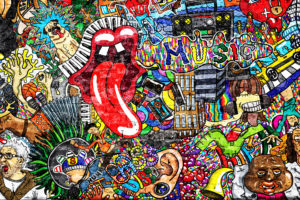The train arrived at the outskirts of Paris when the greatest amount of graffiti I had ever seen jumped out like, well, like graffiti.
As I stared at it, my initial reaction was one of disappointment. This most beautiful of all cities marred by this desecration.
The more I despised it, the more I looked at it. The more I looked at it, the more I was drawn to the range of colors and designs.
I thought, “I’ve never been this captivated in an art museum.”
That’s when I asked,
What is graffiti? Gang tags? Messages from the discontent? Street art? What is it?
I’ve seen graffiti everywhere I’ve ever gone. From the freest places (Amsterdam) to the most repressive places (Riyadh).
I’ve seen graffiti from every century. Ancient Rome, especially ancient Roman ruins. Mayan ruins. Egyptian ruins.
Every city: I used to steam about graffiti as I sat on the Los Angeles Freeways during traffic hours. Now the city has joined the graffiti street art and commissioned artists to paint murals alongside them. If you have to be caught on a freeway, this is a good place to be. As you listen to music, sports, and news talk you are treated to wall art of all types. You’re not wasting away sitting in an asphalt jungle.
Graffiti can be grotesque. Graffiti can be beautiful.
Graffiti: a sign of decay and lawlessness? Sometimes. But it’s also a sign of being alive.
In Pompeii, the graffiti draws the attention of the tourists more than the ruins themselves, mainly because they indicate where prostitutes lived.
Graffiti is the culture under the culture, or should I say the culture on top of the culture. It’s maddening if you want order. Salt Lake City spends $400k a year to supply groups with material to remove graffiti. Most of the graffiti that is removed is gang tagging. This is the battle the city has chosen to fight – civil society vs. gang society.
Graffiti has a variety of styles. Some of it is stenciled graffiti, some of it is of it is carved in (ancient graffiti especially), some of it is done by spray can; some of it appears as blocked lettering. Some of it is legal, some of it commissioned, most of it illegal. It is evident that humans can’t resist covering sterile walls.
There is nothing more ancient, more common, or more personal than graffiti.
I have never once done graffiti, legally or illegally. Except on my notebook in seventh grade. My father did graffiti in our backyard when he painted palm trees on a garage wall facing our pool. In fact he did it on two garage walls. It wasn’t great art, but a hell of a lot more interesting than looking at a garage wall. He was such a quiet man.
I’ve even gotten used to graffiti on human bodies – tattoos. After watching Brandon Steineckert’s YouTube performance of Believe, I had no problem with tattoos running up and down his one arm. (Believe is the theme song for Real Salt Lake soccer team. After I heard Steineckert’s song I went to one of RSL’s soccer games. People dress like Irishmen and Scots. It was like I was at a true working man’s event.)
I no longer believe that cities filled with giant skyscrapers are the most exciting thing I’ve ever witnessed. Walking down a street with music playing and aromas wafting from homes and restaurants with buildings one, two, or thee stories high, with babies crying, and young children laughing, and chalk lines filling the sidewalks, and graffiti here and there makes a good day of life for me. My senses are bombarded. At least I know I am alive. Everything doesn’t have to be new. Old stuff can be fun. Old trees with their branches blowing in the wind.
When I drive down I-15 going from Salt Lake City to Lehi, and I see the long line of train cars rolling in, and I’m shocked by all the graffiti on the box cars. But, I’m also captivated by how aggressive the graffiti is. It is both decadent and alluring at the same time. It is LA culture communicating with conservative Utah culture. At least we know there is something else out there besides ourselves.
